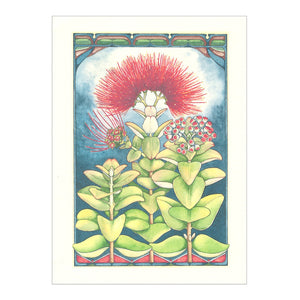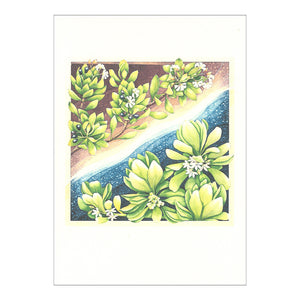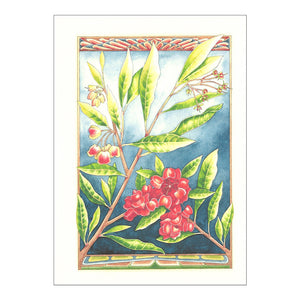{"id":1902167982122,"title":"Notecard: Pua Kala","handle":"notecard-pua-kala","description":"\u003cmeta charset=\"utf-8\"\u003e\n\u003cdiv\u003ePua Kala; Hawaiian Prickly Poppy; \u003cem\u003eArgemone glauca\u003cbr\u003e\u003cbr\u003e\u003c\/em\u003e\n\u003c\/div\u003e\n\u003cdiv\u003e\u003cem\u003e\u003c\/em\u003e\u003c\/div\u003e\n\u003cdiv\u003ePua kala grows on the leeward side of all the main islands in dry, subalpine and coastal forests, and lava deserts. Its seeds can stay viable and dormant for up to ten years until the ground is disturbed by raking , or bulldozing. Because of this \"weedy\" habit, many people pull it out mistaking it for a thistle, the primary reason for pua kala being considered a \"threatened\" species.\u003c\/div\u003e\n\u003cul\u003e\n\u003cli\u003eArtwork by artist Jamie Gilmore\u003c\/li\u003e\n\u003cli\u003eBlank notecard with envelope\u003c\/li\u003e\n\u003cli\u003eDimensions: 5\"x 7\"\u003c\/li\u003e\n\u003c\/ul\u003e","published_at":"2022-05-03T13:09:22-10:00","created_at":"2019-02-28T08:32:04-10:00","vendor":"Hawaii Pacific Parks Association","type":"Audio-Visual","tags":["Hawaii Botanicals","Jamie Gilmore","Kaloko-Honokōhau National Historical Park","Made in Hawaii","Native Plants \u0026 Animals","Notecard","Spring","Under $10","USA Made"],"price":500,"price_min":500,"price_max":500,"available":true,"price_varies":false,"compare_at_price":null,"compare_at_price_min":0,"compare_at_price_max":0,"compare_at_price_varies":false,"variants":[{"id":14600001323050,"title":"Default Title","option1":"Default Title","option2":null,"option3":null,"sku":"2001735","requires_shipping":true,"taxable":false,"featured_image":null,"available":true,"name":"Notecard: Pua Kala","public_title":null,"options":["Default Title"],"price":500,"weight":1,"compare_at_price":null,"inventory_quantity":19,"inventory_management":"shopify","inventory_policy":"deny","barcode":"","requires_selling_plan":false,"selling_plan_allocations":[]}],"images":["\/\/shop.hawaiipacificparks.org\/cdn\/shop\/products\/2001735a.jpg?v=1551396219","\/\/shop.hawaiipacificparks.org\/cdn\/shop\/products\/2001735b.jpg?v=1551396219"],"featured_image":"\/\/shop.hawaiipacificparks.org\/cdn\/shop\/products\/2001735a.jpg?v=1551396219","options":["Title"],"media":[{"alt":null,"id":2929094000682,"position":1,"preview_image":{"aspect_ratio":1.0,"height":1000,"width":1000,"src":"\/\/shop.hawaiipacificparks.org\/cdn\/shop\/products\/2001735a.jpg?v=1551396219"},"aspect_ratio":1.0,"height":1000,"media_type":"image","src":"\/\/shop.hawaiipacificparks.org\/cdn\/shop\/products\/2001735a.jpg?v=1551396219","width":1000},{"alt":null,"id":2929093967914,"position":2,"preview_image":{"aspect_ratio":1.0,"height":1000,"width":1000,"src":"\/\/shop.hawaiipacificparks.org\/cdn\/shop\/products\/2001735b.jpg?v=1551396219"},"aspect_ratio":1.0,"height":1000,"media_type":"image","src":"\/\/shop.hawaiipacificparks.org\/cdn\/shop\/products\/2001735b.jpg?v=1551396219","width":1000}],"requires_selling_plan":false,"selling_plan_groups":[],"content":"\u003cmeta charset=\"utf-8\"\u003e\n\u003cdiv\u003ePua Kala; Hawaiian Prickly Poppy; \u003cem\u003eArgemone glauca\u003cbr\u003e\u003cbr\u003e\u003c\/em\u003e\n\u003c\/div\u003e\n\u003cdiv\u003e\u003cem\u003e\u003c\/em\u003e\u003c\/div\u003e\n\u003cdiv\u003ePua kala grows on the leeward side of all the main islands in dry, subalpine and coastal forests, and lava deserts. Its seeds can stay viable and dormant for up to ten years until the ground is disturbed by raking , or bulldozing. Because of this \"weedy\" habit, many people pull it out mistaking it for a thistle, the primary reason for pua kala being considered a \"threatened\" species.\u003c\/div\u003e\n\u003cul\u003e\n\u003cli\u003eArtwork by artist Jamie Gilmore\u003c\/li\u003e\n\u003cli\u003eBlank notecard with envelope\u003c\/li\u003e\n\u003cli\u003eDimensions: 5\"x 7\"\u003c\/li\u003e\n\u003c\/ul\u003e"}




